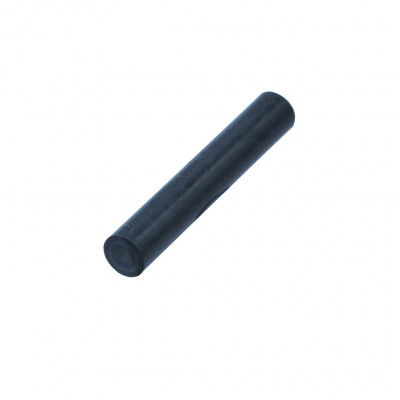Search products
Categories
Search product
Categories
Ketron® PEEK-GF30
Brand: 
- Extremely high maximum operating temperature in air
- High mechanical strength, creep resistance and stiffness, even at elevated temperatures
- Excellent chemical and hydrolysis resistance
- Excellent behaviour under wear and friction
- Low intrinsic flammability and extremely low emission of fumes during combustion
Interested in this product?
This grade, which is reinforced with 30% fibreglass, offers greater stiffness, dimensional stability, and creep resistance than KETRON® PEEK-1000.
It is the ideal material for structural applications intended to support heavy static loads for long periods of time at high
temperatures.
The adaptability of KETRON® PEEK-GF30 to moving parts, however, must be tested thoroughly as the fibreglass in the material tends to abrade the contact parts.
Specifications
- Extremely high maximum operating temperature in air (+250 °C continuously, with peaks up to +350 °C)
- High mechanical strength, creep resistance and stiffness, even at elevated temperatures
- Excellent chemical and hydrolysis resistance
- Excellent behaviour under wear and friction (in particular for KETRON® PEEK - HPV and CA 30)
- Low intrinsic flammability and extremely low emission of fumes during combustion
- Very good dimensional stability
- Good electrical insulation and dielectric properties (except for KETRON® PEEK - HPV and CA 30)
- Excellent resistance against high energy radiation
| Properties | ISO / (IEC) standard | Unit of measurement | Value |
| General properties | |||
| Colour | natural | ||
| Density | 1183-1 | g/cm3 | 1.51 |
| Water absorption: | |||
| - after 24/96 h immersion in | 62 | mg | 5/10 |
| water at 23 °C | |||
| 62 | % | 0.05/0.10 | |
| - at saturation in air of 23 °C / 50% RH | -- | % | 0.16 |
| - at saturation in water of 23 °C | -- | % | 0.35 |
| Thermal properties | |||
| Melting temperature | 11357-1/-3 | °C | 340 |
| Glass transition temperature | 11357-1/-2 | °C | -- |
| Thermal conductivity at 23 °C | - | W (K.m) | 0.43 |
| Average coefficient of linear thermal expansion: | |||
| - average value between 23 and 100 °C | - | m/(m.K) | 30x10-6 |
| - average value between 23 and 150 °C | - | m/(m.K) | 30x10-6 |
| - average value above 150 °C | - | m((m.K) | 65x10-6 |
| Deflection temperature under load: | |||
| - method A: 1.8 MPa | 75-1/-2 | °C | 230 |
| Max. operating temperature in air: | |||
| - for short periods | - | °C | 310 |
| - continuously: min. 20.000 h | - | °C | 250 |
| Min. operating temperature | -20 | ||
| Flammability: | |||
| "Oxygen index" | 4589-1/-2 | % | 40 |
| - according to method UL 94 | - | - | V-0/V-0 |
| (1.5/3 mm thickness) | |||
| Mechanical properties at 23 °C | |||
| Tension test | |||
| - Tensile stress at yield / Ultimate tensile strength | 527-1/-2 | MPa | 80/- |
| - Tensile strain at break | 527-1/-2 | % | 4.5 |
| - Tensile modulus of elasticity | 527-1/-2 | MPa | 7000 |
| Compression test | |||
| - Compressive stress at 1% nominal strain | 604 | MPa | 54 |
| - Compressive stress at 2% nominal strain | 604 | MPa | 103 |
| Charpy impact strength - unnotched | 179-1/1eU | kJ/m2 | 24 |
| Charpy impact strength - notched | 179-1/1eA | kJ/m2 | 3 |
| Ball indentation hardness | 2039-1 | N/mm2 | 250 |
| Rockwell hardness | 2039-2 | - | M 100 |
| Electrical properties at 23 °C | |||
| Dielectric strength | (60243-1) | kV/mm | 24 |
| Volume resistivity | (60093) | Ohm.sq | >1014 |
| Surface resistivity | ANSI/ESD | Ohm.sq | >1013 |
| STM 1111 | |||
| Relative permittivity Â: | (60250) | -- | 3.2 |
| at 100 Hz | |||
| at 1 MHz | (60250) | -- | 3.6 |
| Dielectric dissipation factor. tan ‰: | (60250) | -- | 0.001 |
| at 100 Hz | |||
| at 1 MHz | (60250) | -- | 0.002 |
| Comparative Tracking Index | (60112) | -- | 175 |
| (CTI) |
Although the information provided in this product data sheet is confirmed by reliable research, POLITECNICA CETAI shall not take any responsibility for the application, processing or use of such information.



Share